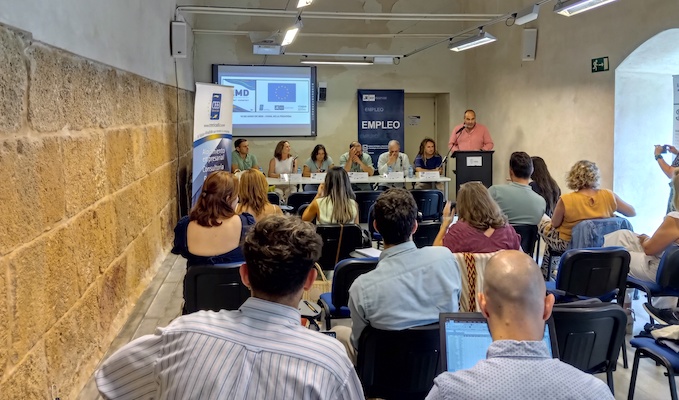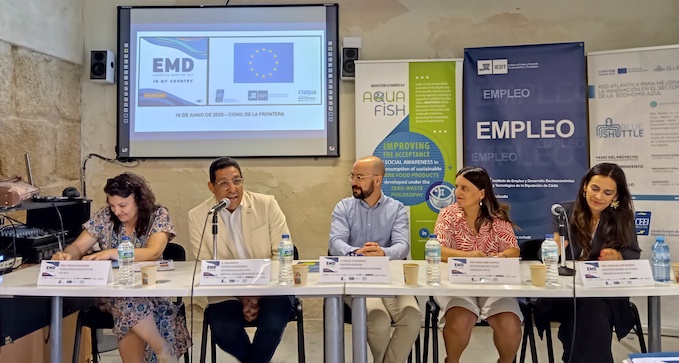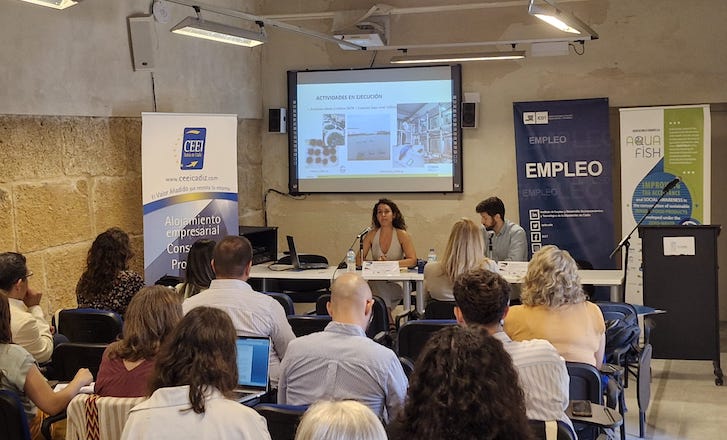Cádiz, became the epicentre of a key event for the future of our seas: “Día Marítimo Europeo en mi Ciudad”
European Commission has approved and supports the development of this joint initiative, on which the IEDT–Diputación de Cádiz, CTAQUA and the CEEI–Bahía de Cádiz have worked together.
On 10 June, this important gathering was held in the emblematic Centro de Interpretación del Mar, las Almadrabas y el Atún “La Chanca” in Conil de la Frontera.
The day was the result of the effort and collaborative track record fostered by key provincial development institutions: the IEDT–Instituto de Empleo y Desarrollo Socioeconómico y Tecnológico of the Diputación de Cádiz, CTAQUA–Centro Tecnológico de la Acuicultura and the CEEI Bahía de Cádiz–Centro Europeo de Empresas e Innovación de Cádiz. This strategic alliance reflects their shared institutional commitment to sustainable development, innovation and job creation as vital pillars of the maritime sector and the Economía Azul.

The EMD is an official annual celebration of the European Union, held every 20 May. With its approval and support, the European Commission also encourages cities to develop smaller‑scale local initiatives with the aim of bringing home the fundamental importance of seas and oceans to the daily lives of Europe’s citizens, and of promoting an “Economía Azul” in the regions as a source of wealth—from traditional maritime sectors to new innovative activities. Thus, the celebration of the EMD acts as an integrative platform where professionals, experts and policy makers debate the challenges and opportunities of the sector, seek solutions that ensure the sustainable use of marine resources and guarantee prosperity in coastal regions. The “EMD in My Country” format makes it possible to amplify, at European level, the impact of the actions undertaken in favour of maritime resources in our territory.
On 10 June we proposed to hold a day divided into THREE BLOCKS. The first, “Camino hacia la digitalización en la acuicultura y transformación de productos marinos”, presented the projects BLUE SHUTTLE and AQUAFISH 0.0 and open a debate on the challenges facing digitalisation in the agri‑food value chain of marine products, focusing on the goal of achieving “Zero Waste”. In addition to CTAQUA and the CEEI‑Bahía de Cádiz, the Universidad Politécnica de Madrid took part.
In the second block, “Puertos y seguridad marítima”, the projects SAFERSEA, the challenge submitted to the SaferSEA – BioAbsoil call, and the NEXOMAR project were presented. Alongside the CEEI‑Bahía de Cádiz, the Consejo Andaluz de Cámaras took part.

After the second block there was a networking session accompanied by an aperitif, before we resume at 16:00 with the third and final block: “El futuro sostenible de la pesca”. Here we proposed a highly interesting debate on the sector’s contribution to marine sustainability, with the participation of professionals of the sea, the OPP72 and the Cofradía de Pescadores de Conil, pioneering companies in the sector, and representatives of the IEO Cádiz‑CSIC (Instituto Español de Oceanografía), the RIRAPE (Red Iberoamericana de Pesca Artesanal de Pequeña Escala) and WWF (Fondo Mundial para la Naturaleza).
We wanted Conil de la Frontera to present the Día Europeo del Mar with a unified vision of the Cádiz Blue Economy, in which all the provincial actors and driving agents strengthen their alliances to continue championing an integrated approach to regional development.
The event counted on the support of the European Commission and the presence of the Diputación de Cádiz’s Deputy for Promotion and Employment and vice‑president of the IEDT, Andrés Clavijo, as well as the mayoress of the Ayuntamiento de Conil de la Frontera, Inmaculada Sánchez Zara.
WHERE WE MET
The chosen venue, the Centro de Interpretación del Mar, las Almadrabas y el Atún – La Chanca, speaks for itself. More than 7,000 square metres of the former 16th‑century almadraba industry facilities have been reconverted into a socio‑cultural space featuring an Interpretation and Documentation Centre, the municipal library José Velarde and a central courtyard that hosts events throughout the year.
The premises consist of a group of 15th‑century buildings (erected by the Duque de Medina Sidonia between 1540 and 1560) originally devoted to the almadraba industry. During the fishing season, tuna were cut up here, salted and packed into barrels for marketing. Out of season, La Chanca turned into a vast warehouse for the gear and other items used in the almadraba, such as barges, buoys, anchors and nets. It boasted offices, employees’ dwellings, kitchens, stables, haylofts and granaries. Within it stands out a large structure known as the "Bóveda de Sal", used to store this essential product for preserving tuna.
AN INNOVATIVE AND STRATEGIC PROGRAMME AT “LA CHANCA”
The day’s agenda in Conil de la Frontera was strategically designed to explore the most relevant facets of the Economía Azul, focusing on digitalisation, maritime safety and the sustainable future of fishing.
AQUAFISH 0.0 is a project funded by ERDF through the INTERREG Atlantic Area 2021-2027 programme (project code EAPA_0062/2022).


